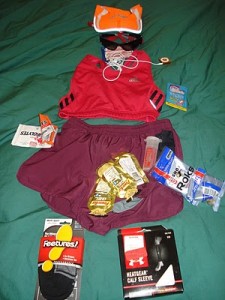If you’re a beginning runner or someone who hasn’t raced much, race day can be terrifying.
The pressure of testing your fitness level, your mental resolve, and finally seeing if all that hard work was worth it is culminating today. No wonder why you feel anxious, there’s a lot riding on this race!

You might be someone who puts a lot of pressure on yourself to run a certain time. Or you may just want to see where your fitness is at this point in your training. Hell, you may even want to win the race.
No matter who you are, you’re going to be nervous. And that’s okay.
I think some race anxiety is healthy – it’s a good reminder that you’re human, you’re about to do something stressful (but rewarding), and it prepares you to perform.
But don’t sabotage yourself. Every runner should prepare for race day and execute that plan as best as possible. It will help you avoid negative stress and provide the opportunity you need to race at your best.
Certain rules can help you stay organized and reduce anxiety the morning of a race. What follows are lessons I’ve learned from 13 years of competitive racing. Note that these apply to any race – an indoor track 800m, road 10k, or even a marathon.
Never try something new on race day
Okay, I can hear it now: “But I wore new socks in a race and I ran a PR!” That’s not the point. Very minor things can always be changed, but when you tinker with important aspects of your racing you could sabotage yourself. Don’t even think about changing:
- Your race strategy. If you have practiced race pace during your training (you should have!), then execute that on race day. Don’t go out too fast with the hope of holding that pace. Or alternately, don’t go out too slow and hope to negative split the last half. Be smart.
- Your racing shoes. New shoes can be a gamble – what if they give you blisters? Or surprisingly slippery when it’s wet? Or too narrow at the heel/toebox/midfoot? Your racing shoes should have at least 10-20 miles in them so you’re comfortable in them, know how they respond to your stride, and are aware of exactly how they feel. I stick with my Hyper Speeds.
- Your breakfast. Look, I love veggie omelettes topped with smoked salmon and melted goat cheese just like the next person. But stick to basic foods that you know your stomach can handle. Trying to run fast on unfamiliar food can result in a lot of unpleasantness, so eat familiar and easy digestible foods.
- Your warm-up. Treat every race like a hard workout in that you warm-up the same way. Not warming up – or just as bad, warming up for way too long – is going to affect how you perform. Do what you know, are comfortable with, and gets you adequately prepared to run fast.
Experimentation is for training when your performance doesn’t matter as much. You can tinker with gels, fueling mid-run, different warm-ups, new shoes and other gear, and pacing strategies. Race day should be controlled.
Pack your bag the night before the race
This seems simple enough, but I’ve heard too many horror stories about runners not having clean shorts or arriving late because they spent two hours searching for their favorite racing shoes. Having a successful race is about being calm on race day – eliminate as much potential stress as possible by packing everything you need the day before your race.
arriving late because they spent two hours searching for their favorite racing shoes. Having a successful race is about being calm on race day – eliminate as much potential stress as possible by packing everything you need the day before your race.
A helpful way to never forget any gear is to lay out your gear in the shape of a person. By including your shoes near the “feet,” shorts, singlet, visor if you use one, etc. you’ll see exactly what’s missing.
You should also prepare your breakfast, water bottles, recovery food, and any drink mixes (electrolytes or a protein shake) the night before your race. Saving time on race morning will allow you to get to the race earlier, relax, and get in the right mental frame of mind to achieve your potential.
It’s a much better alternative to freaking out because you took too long to make your morning oatmeal, pack your 6 GU packets, and mix your post-race protein shake.
A distance race can’t be won in the first minute, but it can be lost
Don’t go out over your head during those first few crucial minutes. You’ll just dig a hole you can’t run out of. Your pace will be writing checks your aerobic system can’t cash. Don’t sprint up Shits Creek without waterproof shoes.
I went a little overboard with that analogy didn’t I?
A friend gave me this recommendation about a year ago before I ran an 8k. I payed special attention to running conservative during that first mile, and actually ran much faster than I thought. While my effort was lower, my pace was still a bit faster than my average. What would have happened if I pushed the first mile?
Physiologically, the goal in any race is to keep your effort aerobic for as long as possible. This ensures you’re not going into oxygen debt and producing too much acid in your muscles. While that’s expected later in the race, if it happens too early you’re going to crash and burn. So keep your initial pace under control and you’ll set yourself up for a much faster race overall.
Never attack a hill from the bottom
Keep your effort level consistent, even though your pace will naturally slow. During a hilly race, you want to keep in mind the lesson of staying aerobic for as long as possible. Trying to attack every hill from the bottom will put you in oxygen debt quickly.
Once you get about a third of the way up the hill, you can dial up the pace and run slightly faster. This has the added advantage of dropping competitors when they’re most likely struggling.
Bonus strategy: When you hit the top of the hill, put in a surge to drop your competitors, break their spirit, and wake your legs up. It’s a more advanced strategy, but it’s almost guaranteed to put distance between you and the nearest runner.
Race with a training partner
If you train with somebody who is close to your ability, convince them to race with you. It’s always surprising to see how much harder you can push yourself when you have a partner challenging you. Studies have shown that perceived effort is significantly lower when you’re in a group setting as opposed to running solo.
Some of my best races have happened when I ran close to another runner of a similar ability. You’ll feed off their surges, respond to their good performances, and perform at a higher level. So recruit a training partner to come with you to your next race – you may just surprise yourself at how much faster you’re able to run.
Run the tangents!
I’ve said this before, but I’m incredulous every time I’m at a race at how many runners run the long way on the race course. Races are measured on the tangents and on the shortest distance around curves, so don’t make the course longer than it has to be.
Look at the example below. The red line represents the least distance around this curvy road and how you should race. The green line is how most runners race – longer and slower!

Think about it this way: if you go the long way in a local 5k, like running along the right shoulder of the road when it’s curving to the left, you could be adding as much as 5-20 seconds per mile to your final time. If the course permits and you’re not surrounded by other runners who are pushing you to the outside corners, run those tangents!
Know the course before you arrive
This is crucial if you want to run the tangents and just as important when planning your race strategy. Knowing the uphills, downhills, and sharp turns will help you determine when to surge or be conservative with your pace. I memorized every detail of our home cross country course in college, including exact moments when I would surge to surprise my competitors. Yes, I am a huge nerd.
It’s more important if you’re closer to the lead group, but I think this is a valuable lesson for everyone. You’ll see where there are potholes, manhole covers (avoid them when it’s raining – they get incredibly slippery), and valuable shade during summer races.
Getting to know a race course is sometimes impractical, especially if you’re traveling a long distance. If you have the ability to drive a course and take notes (welcome to the team, fellow nerd!) then I would highly recommend it.
Plan your mile splits based on your current fitness level before the race
They’ll help you stay on pace and give you an outline of how the race should unfold from mile to mile. I find it much more valuable for longer races like 10k’s or more when rationing your effort and energy is vital to finishing strong.
If you’re racing on the track, it may be helpful to plan your 400m splits so you can get feedback after every lap. After the race-specific workouts you did during training, you’ll be ready to tick off those laps like clockwork.
Keep in mind this is of course a template for your performance and your actual splits will vary, but it’s a good idea to plan your pace ahead of time. You can use a temporary pace tattoo like those sold at Pace Tat for half-marathons or marathons.
I actually mailed a few of these to subscribers about a year ago. If you’re interested, sign up for future gear giveaways here.
Execute a Race Day Routine
Before every race, you should have a specific routine that you go through that’s the same every single time. Systematizing your race day routine is going to reduce stress, give you more time to focus on your race, and make you more confident that things are going smoothly.
I have a routine that stays constant before every race. It’s been refined over the years and I’ve found what works for me. I recommend you do the same, but I want to show you my exact routine to help you develop your own.
- The night before, I lay out my backpack with my water bottle, recovery food (protein shake and some type of energy bar), and gear. I also lay out my shorts, singlet, socks, and racing shoes. If I need to do laundry, I’ll get that done as well.
- I print out directions to the race, look at a map just in case they’re confusing, and set two alarms for 3-4 hours before the race start.
- When I wake up, I change into my shorts, socks, and any gear that I’m wearing over my racing uniform. This is of course based on the weather.
- I immediately eat a piece of wheat toast with peanut butter and a banana. With two hours until the start of the race, I start drinking a 12 ounce coffee.
- Hydration is important, but I don’t drink much water in the final hour before the start. I want my body to absorb everything I drank in the 2-3 hours beforehand. I try to drink at least 30 ounces of water – more if it’s hot and the race is longer.
- I get to the race at least an hour before the start, get my number if I don’t already have it, and pin it to my singlet. I always carry extra pins just in case race staff have run out of them.
- With 35-40 minutes until the start of the race, I do the cannonball and lunge matrix routines and start my 3 mile warm-up run. I always include about one minute of faster runner near the end of this warm-up run, which takes me about 21-22 minutes.
- After the warm-up run, I change into my racing shoes (I wear the ASICS Hyper Speeds for most races) and singlet, take off any extra articles of clothing, and go to the starting line.
- With 5-10 minutes before the start, I run 6-8 strides of 100 – 150m in length. My first few are slower and longer but they get shorter and faster as I loosen up and increase my range of motion and heart rate.
- Once I’ve primed my body to run fast there’s nothing left to do but wait. I don’t fidget much on the starting line like a lot of runners because I know I’ve prepared. I don’t need to hit my legs or jump up and down.
- After the race, I focus on rehydrating, eating my recovery food, and doing at least 10-15 minutes of core work. I also diligently use my foam roller to massage any particularly sore muscles. I may also use my calf compression sleeves to enhance recovery.
This routine stays exactly the same for almost all of my races. Exceptions include half-marathons or marathons when I’ll plan my race fueling and pack more gels. I don’t eat or drink anything during races 10 miles or less because they take me less than an hour. If you’re not racing for longer than an hour, you don’t need calories and only need water if it’s very hot and humid.
By standardizing my pre-race ritual, I know what to expect and I rarely get stressed out. I’m always prepared and there’s rarely a surprise or crisis on race day.
After you finish, it’s always a good idea to do a thorough race post-mortem to learn from your experience. What went wrong? What did you dominate? Is your fitness increasing as expected?
Take the guesswork out of running a great race and give yourself the best possible chance to run well on race day. Get a routine and stick to it. What are your strategies to running stress-free on race day? How do you prepare?